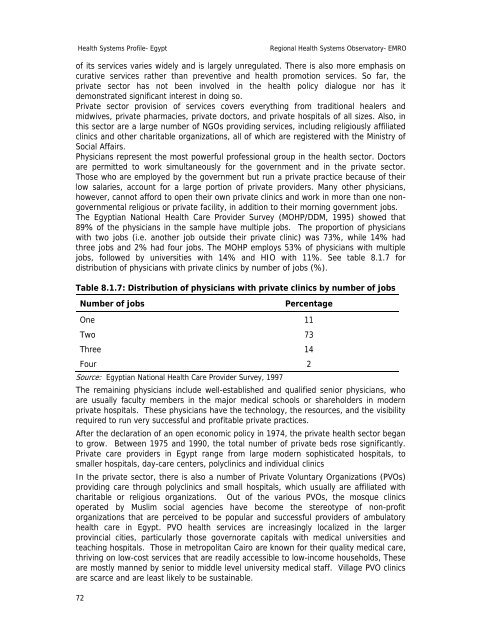Egypt : Complete Profile - What is GIS - World Health Organization
Egypt : Complete Profile - What is GIS - World Health Organization
Egypt : Complete Profile - What is GIS - World Health Organization
Create successful ePaper yourself
Turn your PDF publications into a flip-book with our unique Google optimized e-Paper software.
<strong>Health</strong> Systems <strong>Profile</strong>- <strong>Egypt</strong> Regional <strong>Health</strong> Systems Observatory- EMRO<br />
of its services varies widely and <strong>is</strong> largely unregulated. There <strong>is</strong> also more emphas<strong>is</strong> on<br />
curative services rather than preventive and health promotion services. So far, the<br />
private sector has not been involved in the health policy dialogue nor has it<br />
demonstrated significant interest in doing so.<br />
Private sector prov<strong>is</strong>ion of services covers everything from traditional healers and<br />
midwives, private pharmacies, private doctors, and private hospitals of all sizes. Also, in<br />
th<strong>is</strong> sector are a large number of NGOs providing services, including religiously affiliated<br />
clinics and other charitable organizations, all of which are reg<strong>is</strong>tered with the Min<strong>is</strong>try of<br />
Social Affairs.<br />
Physicians represent the most powerful professional group in the health sector. Doctors<br />
are permitted to work simultaneously for the government and in the private sector.<br />
Those who are employed by the government but run a private practice because of their<br />
low salaries, account for a large portion of private providers. Many other physicians,<br />
however, cannot afford to open their own private clinics and work in more than one nongovernmental<br />
religious or private facility, in addition to their morning government jobs.<br />
The <strong>Egypt</strong>ian National <strong>Health</strong> Care Provider Survey (MOHP/DDM, 1995) showed that<br />
89% of the physicians in the sample have multiple jobs. The proportion of physicians<br />
with two jobs (i.e. another job outside their private clinic) was 73%, while 14% had<br />
three jobs and 2% had four jobs. The MOHP employs 53% of physicians with multiple<br />
jobs, followed by universities with 14% and HIO with 11%. See table 8.1.7 for<br />
d<strong>is</strong>tribution of physicians with private clinics by number of jobs (%).<br />
Table 8.1.7: D<strong>is</strong>tribution of physicians with private clinics by number of jobs<br />
Number of jobs Percentage<br />
One 11<br />
Two 73<br />
Three 14<br />
Four 2<br />
Source: <strong>Egypt</strong>ian National <strong>Health</strong> Care Provider Survey, 1997<br />
The remaining physicians include well-establ<strong>is</strong>hed and qualified senior physicians, who<br />
are usually faculty members in the major medical schools or shareholders in modern<br />
private hospitals. These physicians have the technology, the resources, and the v<strong>is</strong>ibility<br />
required to run very successful and profitable private practices.<br />
After the declaration of an open economic policy in 1974, the private health sector began<br />
to grow. Between 1975 and 1990, the total number of private beds rose significantly.<br />
Private care providers in <strong>Egypt</strong> range from large modern soph<strong>is</strong>ticated hospitals, to<br />
smaller hospitals, day-care centers, polyclinics and individual clinics<br />
In the private sector, there <strong>is</strong> also a number of Private Voluntary <strong>Organization</strong>s (PVOs)<br />
providing care through polyclinics and small hospitals, which usually are affiliated with<br />
charitable or religious organizations. Out of the various PVOs, the mosque clinics<br />
operated by Muslim social agencies have become the stereotype of non-profit<br />
organizations that are perceived to be popular and successful providers of ambulatory<br />
health care in <strong>Egypt</strong>. PVO health services are increasingly localized in the larger<br />
provincial cities, particularly those governorate capitals with medical universities and<br />
teaching hospitals. Those in metropolitan Cairo are known for their quality medical care,<br />
thriving on low-cost services that are readily accessible to low-income households, These<br />
are mostly manned by senior to middle level university medical staff. Village PVO clinics<br />
are scarce and are least likely to be sustainable.<br />
72

















